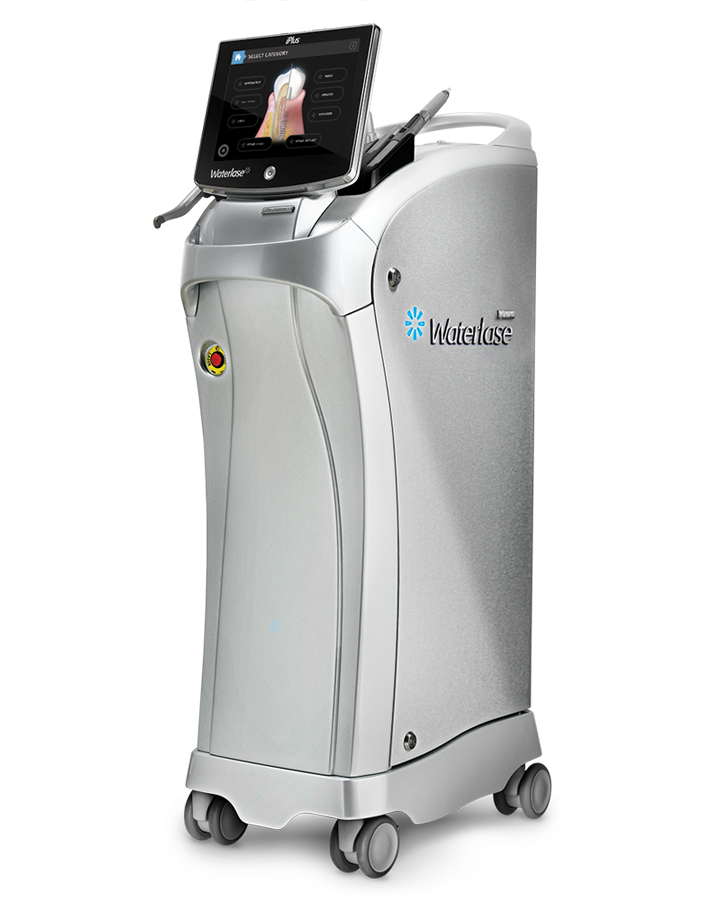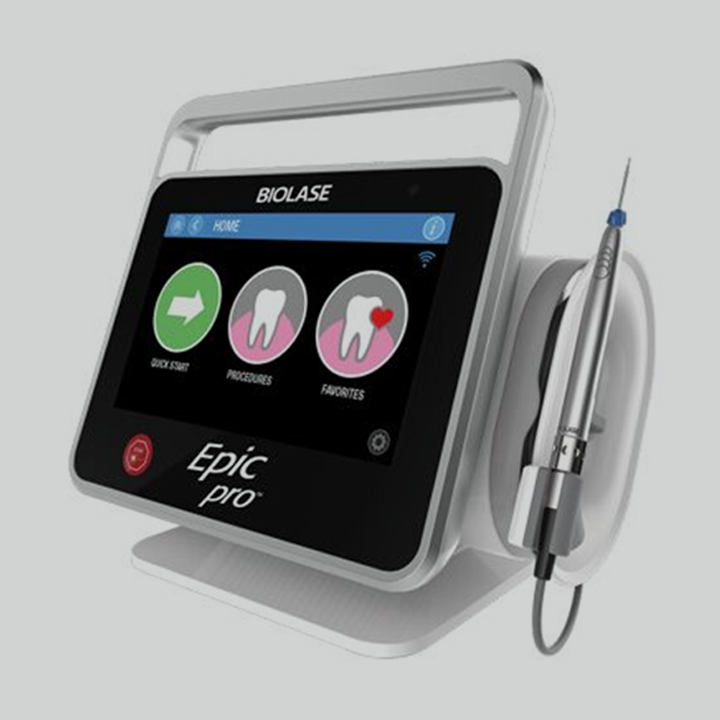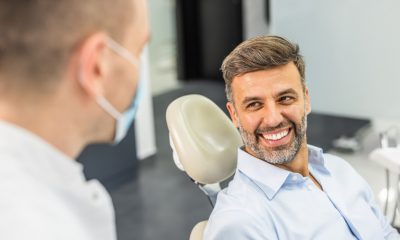Laser Assisted Dentistry
What is laser dentistry?
Laser dentistry is cutting edge and offers a more comfortable solution to a host of dental issues involving both hard and soft tissue. Robin Horton has been using them since 2001 and Wayside now has nine dental lasers. As the body of evidence for their use is ever growing, so is their popularity and the demand for teaching. In 2023, as well as teaching on webinars to an international audience, Dr Robin Horton travelled to Berlin, the US, Dubai, Japan and Taiwan to teach dentists who are keen to start using these remarkable tools.
- Lasers provide huge benefits to the patient, giving improved comfort, faster healing and for many treatments, better results. We currently use two types of lasers, a Diode (soft tissue laser) and a Waterlase (all tissue soft and hard) both of which are manufactured by Biolase, the world leaders in dental lasers.
- We use the Diode laser, which uses a wavelength of 940nm, for gum treatments and healing, known as photobiomodulation, or PBM.
- We use the Waterlase laser, which uses a wavelength of 2780nm, for both hard and soft tissue treatments; from gum recontouring, root fillings to extractions and in implant surgery.
- At Wayside we have 5 Diode lasers and 4 Waterlase lasers- more than any other dental practice in Europe.
- All our dentists at Wayside Dental can offer laser assisted dentistry and three of our hygienists use lasers for gum disease treatments. Most dentists and hygienists who begin to use lasers wonder how they ever managed without them!
- Using lasers requires an additional skill set and all our dentists and three of our hygienists have completed comprehensive training in their use. Our nurses are all trained in laser safety. Dr Robin Horton is a fellow of the worldwide Academy of Laser Dentistry and Dr Amit Maisuria was one of the first dentists to be awarded a diploma in laser dentistry from the prestigious Eastman Dental Institute, UCL.

WHEN ARE DENTAL LASERS USED?
Lasers are suitable for both treatment and to promote healing
- For treatment, lasers can be used on soft tissue (such as gums), in place of a scalpel and hard tissue (such as tooth enamel and bone), in place of a drill or extraction instruments.
- For healing, the laser light initiates a complex biological action which effectively allows cells to repair themselves. The light also encourages healing cells to navigate to the area. When we use PBM, we find much less inflammation and faster healing which, combined with their precise, minimally invasive, and anti-bacterial action, make them the perfect tools for comfortable dentistry.
- Lasers come in different types which are specially designed for different kinds of tissue.


THE WATERLASE LASER
The Waterlase Dental laser is one of the most advanced dental treatments available today. Its wavelength is absorbed by water and hydroxyapatite (the mineral that makes up tooth and bone).
What can the Waterlase Laser be used for?
- Fillings and Tooth Preparation
The laser can, in the right circumstances, be used to prepare a tooth for a filling in place of a drill. The laser works without heat or vibration, so causes little or no discomfort and this also protects the surrounding enamel and stops microfractures. It is so precise that it preserves more of the healthy tooth structure and destroys bacteria locally to ensure no contaminant is left in the tooth. It is great for children’s fillings as it is minimally invasive as well as being comfortable. It also does not make the noise a drill makes-just a popping sound. - Children’s Laser Dentistry
The Waterlase laser can be used instead of a drill or scalpel and its gentle action can help eliminate any fear and anxieties associated with dental visits. It is the preferred treatment for tooth decay with no heat, vibration and shrill sound of the drill. For other treatments, such as tongue tie release and frenectomies, there is less trauma to the area and faster healing. - Root Canal Treatments
A laser can be used for enhanced deep cleaning and disinfection of the root canal system. In fact, many endodontists around the world are choosing to use the Waterlase laser with its specially designed tip to sterilise all the way down the root canal. Using a laser also helps to initiate the body’s healing process. - Gum Disease/Periodontal Treatments
Laser treatment is already used by many periodontists (gum disease specialists) worldwide for the treatment of gum disease. Gum disease, if left untreated, can cause tooth loss as the tooth’s attachment to the tissues is destroyed by the presence of bacteria.
Gum disease is the body’s aberrant inflammatory response to the presence of bacteria and this aberrant response prevents the body from healing. Because of this, lasers are in most cases the ideal tool for treatment- lasers kill bacteria and allow and indeed encourage the body to heal. Lasers can also reach deep into the pockets. This means in many cases, periodontal disease can be treated without the need for painful surgery. If the gum disease resurfaces, we can laser treat it again if you have responded well to laser treatment in the past. - Dental Implants
We place all our implants using the laser. It is so precise that the site can be prepared with minimal trauma to the surrounding tissue, and there is very little bleeding with often no need for stitches. The action of the laser greatly reduces the inflammatory response so there is much less discomfort following surgery-in fact some patients report no discomfort at all!
The laser also sterilises the area, promotes healing of soft tissue and regeneration of new hard and soft tissue. This reduces the chance of infection, improves wound healing, and encourages new bone growth to integrate the implant into the jaw. Robin has been using dental lasers in his implant surgery for over 15 years. - Surgical Extractions
Laser use is a kinder way to extract teeth. We use it to gently cut away the ligaments and if necessary, segment the tooth so there is much less trauma to surrounding tissues, and most importantly if you are having an implant, more bone is preserved. It is the quality of bone that is optimal in implant surgery. - Soft Tissue Surgery
The Waterlase laser is a superb tool for any soft tissue treatments as it is so gentle, precise and minimally invasive. It also kickstarts healing. We use it for frenectomies, cyst removal and gum contouring.
THE DIODE LASER
The Diode Laser is a soft tissue laser and, because its wavelength is absorbed by soft tissues and haemoglobin, it is also a therapeutic laser.
What can the Diode Laser be used for?
- Photobiomodulation (healing) Therapy
The main use for this laser at Wayside is for healing. The wavelength of the light energy is absorbed into tissues to stimulate the healing process in damaged cells. This light also recruits healing cells to the area to help with the process. Healing is encouraged and pain and inflammation reduced, wherever the beam is applied. It can be used to help with and eliminate TMJ pain and we use it after any surgical procedure. It is also a treatment recognised by NICE for patients with mucositis. - Treatment of Gum Disease
The Diode laser can be used to treat gum disease as it eliminates bacteria and encourages healing. - Soft Tissue Surgery
The Diode can be used for soft tissue surgery, including frenectomies.



